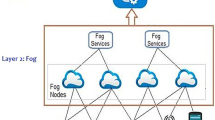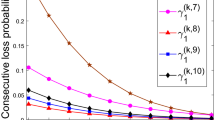Abstract
This paper studies the behavior of a discrete queueing system which accepts synchronized arrivals and provides synchronized services. The number of arrivals occurring at an arriving point may follow any arbitrary discrete distribution possessing finite first moment and convergent probability generating function in ¦ z ¦ ⩽ 1 + ɛ with ɛ > 0. The system is equipped with an infinite buffer and one or more servers operating in synchronous mode. Service discipline may or may not be prioritized. Results such as the probability generating function of queue occupancy, average queue length, system throughput, and delay are derived in this paper. The validity of the results is also verified by computer simulations.
Similar content being viewed by others
References
N. Abramson, Packet switching with satellites, AFIPS Conf. Proc. National Computer Conf. 42 (June 1973) pp. 695–702.
J.K. DeRosa and L.H. Ozarow, Packet switching in a processing satellite, Proc. IEEE 66 (1978) 100–102.
R.E. Eave, ALOHA/TDM systems with multiple downlink capacity, IEEE. Trans. Commun. COM-27 (1979) 537–541.
J.K. DeRosa, L.H. Ozarow and L.N. Wiener, Efficient packet communications, IEEE Trans. Commun. COM-27 (1979) 1416–1422.
J.F. Chang, Packet communications via satellite with buffer and multiple downlinks, J. Inst. Chin. Eng. 5 (1982) 35–41.
J.F. Chang, Packet satellite system with multiple uplinks and priority discipline, IEEE Trans. Commun. COM-30 (1982) 1143–1152.
R.V. Churchill,Complex Variables and Applications, 2nd ed. (McGraw-Hill, New York, 1960).
B.A. Powell and B. Avi-Itzhak, Queueing systems with enforced idle time, Oper. Res. 15 (1967) 1145–1156.
S.C. Dafermos and M.F. Neuts, A single server queue in discrete-time, Cahiers du Centre d'Étude de Recherche Opérationnelle 13(1) (1971) 23–40.
J.R. Louvion, P. Boyer and A. Gravey, A discrete-time single server with Bernoulli arrivals and constant service time,Proc. ITC12 Torino (1988) 2.4B.2.1–2.4B2.8.
H. Ahmadi and R. Guérin, Analysis of a class of buffer storage systems with Markov-correlated input and bulk service,Proc. 4th Int. Conf. on Data Communication Systems and their Performance, Barcelona (1990) pp. 67–84.
J.N. Daigle and Y. Lee and M.N. Magalhaes, Discrete-time queues with phase dependent arrivals,Proc. IEEE INFOCOM'90 (1990) pp. 728–732.
O. Hashida, Y. Takahashi and S. Shimogawa, Switched batch Bernoulli process (SBBP) and theSBBP/G/1 queue with application to statistical multiplexer performance, Research Report, Grad. Sch. Systems Management, Univ. of Tsukuba, Tokyo 112, Japan, No. 90-08 (July, 1990).
I. Rubin, Access-control disciplines for multiaccess communication channels: Reservation and TDMA schemes, IEEE Trans. Inform. Theory IT-25 (1979) 516–536.
N.K. Jaiswal,Priority Queues (Academic Press, New York, 1968).
B.G. Kim, A single-server discrete-time queueing system: with and without priorities,Proc. IEEE GLOBECOM'88 (1988) pp. 522–526.
I. Rubin and Z. Tsai, Message delay analysis of multiclass priority TDMA, FDMA, and discrete-time queueing systems, IEEE Trans. Inform. Theory IT-35 (1989) 637–647.
M. Sidi, Two competing discrete-time queues with priority, Queueing Systems 3 (1988) 347–362.
Y. Takahashi and O. Hashida, Delay analysis of discrete-time priority queues: A new approach, NTT R&D Report, No. 3855 (March, 1990).
Author information
Authors and Affiliations
Additional information
The work reported in this paper was supported by the National Science Council of the Republic of China under Grant NSC1981-0404-E002-04.
Rights and permissions
About this article
Cite this article
Chang, JF., Harn, YP. A discrete-time priority queue with two-class customers and bulk services. Queueing Syst 10, 185–211 (1992). https://doi.org/10.1007/BF01159206
Received:
Revised:
Issue Date:
DOI: https://doi.org/10.1007/BF01159206




